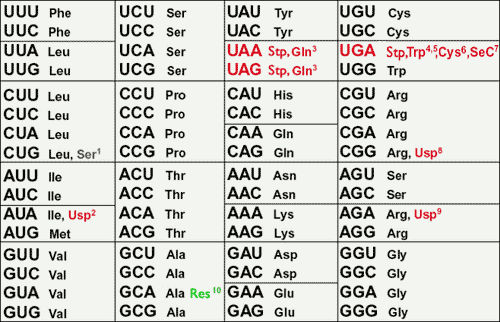John Collyer's eleventh point was that the "genetic code in every form of life is a precise set of information for the development and activity of that form of life, accompanied by elaborate transmission and duplication systems, without which life would cease. This complexity cannot be accounted for by chance, but testifies to intelligent design in every form of life."
Once again, Collyer has conflated abiogenesis and evolution. The former refers to the origin of life while the other explains how the diversity of life over time has emerged. They are separate disciplines and the problems with the former do not make the considerable evidence for the latter suddenly disappear. Furthermore, Collyer has once more invoked the argument from personal incredulity. Just because a layperson with no relevant background in origin of life studies cannot imagine how the genetic code evolved does not mean that a naturalistic origin for the genetic code will never be found.
What Collyer also fails to point out is that there are variations to the universal genetic code. Slight alterations to the standard genetic code exist in yeasts, ciliates, bacteria, and the mitochondrial DNA of many taxa:
- The Standard Code
- The Vertebrate Mitochondrial Code
- The Yeast Mitochondrial Code
- The Mold, Protozoan, and Coelenterate Mitochondrial Code and the Mycoplasma/Spiroplasma Code
- The Invertebrate Mitochondrial Code
- The Ciliate, Dasycladacean and Hexamita Nuclear Code
- The Echinoderm and Flatworm Mitochondrial Code
- The Euplotid Nuclear Code
- The Bacterial, Archaeal and Plant Plastid Code
- The Alternative Yeast Nuclear Code
- The Ascidian Mitochondrial Code
- The Alternative Flatworm Mitochondrial Code
- Blepharisma Nuclear Code
- Chlorophycean Mitochondrial Code
- Trematode Mitochondrial Code
- Scenedesmus Obliquus Mitochondrial Code
- Thraustochytrium Mitochondrial Code
- Pterobranchia Mitochondrial Code
- Candidate Division SR1 and Gracilibacteria Code
 |
| Figure 1.1.1. The standard genetic code and known variant nuclear codes. (1) Candida, a unicellular yeast. (2) Micrococcus. (3) ciliated protozoans and green algae. (4) Mycoplasma. (5) suppressor codon in bacteria. (6) Euplotes. (7) the selenocysteine codon (8) Spiroplasma. (9) Micrococcus. (10) resume codon in ssrA RNA (Lehman 2001). Source: Theobald, Douglas L. "29+ Evidences for Macroevolution: The Scientific Case for Common Descent." The Talk.Origins Archive. Vers. 2.89. 2014. 14 May 2014 <http://www.talkorigins.org/faqs/comdesc/> |
It is worth noting that these minor variations to the standard genetic code are associated with major taxonomic groups (phyla or greater) whose origins stretch back hundreds of millions of years. It is believed eukaryotic cells were formed around 1.6 - 2 billion years ago due to endosymbiosis involving a proto-eukaryotic cell and a smaller bacteria-like cell, which means that the ancestor of the mitochondria likewise was a member of a major taxonomic group. In fact, three years before Crick, Brenner, Gamow, and other scientists solved the genetic code, Hinegardner and Engelberg predicted that " if different codes do exist they should be associated with major taxonomic groups such as phyla or kingdoms that have their roots far in the past." [1]
The universal genetic code is what we would expect with common descent. Minor variations were predicted to be found at the base of the tree of life. Special creation conversely has no explanation as to why God would arbitrarily alter the genetic code in minor ways, and only at the base of the tree of life where one would expect minor changes to be frozen. In fact, the existence of two genetic codes in the eukaryotic cell - nuclear and mitochondrial - raises the question of what pressing purpose God had to have two variations of the genetic code in a single cell.
The idea of a genetic code with "elaborate transmission and duplication systems" is hard to reconcile with RNA viruses. These have a very high mutation rate because RNA polymerases can’t proof-read the code to detect errors in the same way DNA polymerases can. One consequence of this is that it is hard to make a vaccine effective at preventing the diseases caused by RNA viruses such as Hepatitis C. A special creationist who argued that God specially created the RNA viruses with poor proof-reading for their genetic code, which among other things would make it hard for humans to make reliable vaccines to prevent the significant morbidity and mortality that arises from these diseases is making a very, very bold theological claim.
References
1. Hinegardner, T. T., Engelberg, J. "Rationale for a Universal Genetic Code." Science (1963) 142: 1083-1085.